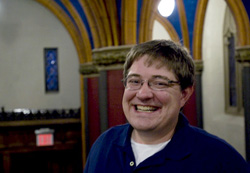Filed Under > TC People
Gaming Geek with the Gift of Gab
When it comes to 'performing' super-human feats like leaping off rapidly descending elevators or rolling giant spheres around a gravity-shifting room, mere mortal Phillip Stewart, a third-year TC graduate student, doesn't even blink.
When it comes to “performing” super-human feats like leaping off rapidly descending elevators or rolling giant spheres around a gravity-shifting room, mere mortal Phillip Stewart, a third-year TC graduate student, doesn’t even blink. Why? For one, the self-professed gaming fan grew up glued to Nintendo classics, such as Super Mario Brothers and Metroid. And as any gaming aficionado knows, in a virtual world, anything is possible.
When applying his extensive gaming knowledge to his academic life, Stewart adopts a similar attitude—and recently, that’s paid off. In 2009, Stewart was awarded the ninth annual Walter Sidlinger Writing Award for his essay “Physics Geeks and Game Readiness,” which explores how conceptual physics students interact with the 3D serious game Physics Geeks and whether or not the game, a brainchild of the Virtual Learning Worlds team at Columbia University, facilitates learning.
Physics Geeks was brought to its imaginative life by the collective efforts of Susan Dreher of the Columbia Center for New Media Teaching and Learning, who acted as the primary software developer; programmer Rob Lane of Columbia’s National Science Digital Library, who served as project manager for Physics Geeks; and Stewart, who designed the educational content of the virtual worlds.
“The goal of the game is for students to interact with physical objects in a way that’s not possible in the real world,” says Stewart. “The site exaggerates what mechanics do to make the physics more obvious. So the elevator module exaggerates speed and acceleration of the elevator so that if, say, the elevator is going upwards and you jump off, you continue to go upwards for a while before gravity brings your speed down to zero, and you then start falling to the ground. In the real world, you would not continue upwards for an obvious moment of time—nor could you jump off the elevator in the first place without losing your life. In the Doppler Effect module, as they walk toward the train, they can see a graph of the pitch shift and see how the sound is changing. In the real world, you cannot tell what notes a police car is giving off.”
The games, which Stewart hopes to study further as he begins his dissertation next year, “could save money for science programs that can’t buy the physical equipment.” He said the hope was that virtual worlds, or “physics playgrounds,” could be created as spaces where students from different geographical areas could learn together, similar to Quest Atlantis, an international learning and teaching project of Indiana University
Stewart, who credits TC faculty member Jessica Hammer’s “Video Games and Education” course as a transformative event in his academic career, says, “The class really broadened my horizons and gave me the vocabulary to talk about games in a critical way, making me want to ask, ‘What can we learn about games as educators? Why not figure out what they’re doing that works and apply that in school?’”
Stewart combines his love of technology and games with a strong affinity for writing, as evidenced by his winning the Sidlinger Award’s $1,000 prize. Cormac McCarthy and Raymond Carver are his favorite authors. But it was in the humanities program at Davidson University
“They asked me if I was an English major,” he says.
Published Thursday, Feb. 4, 2010
